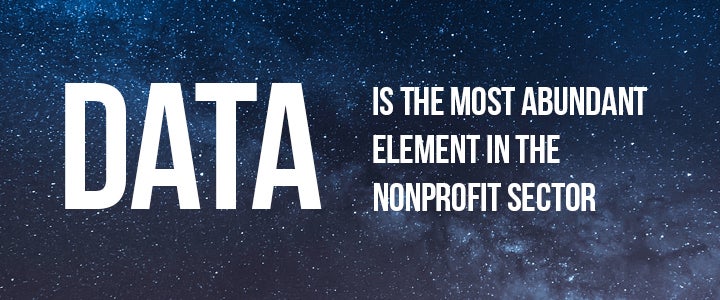
Data is the most abundant element in the nonprofit sector. Data traces our paths and measures our efforts to drive meaningful change in the world. Data informs us about supporters, members, and funders. Data provides insights into the success of our engagement, campaigns, and programs. Data makes it possible to understand the impact of our actions and the reach of our outcomes.
Unfortunately, far too many nonprofit and social good organizations struggle to transform their data into measurable value. In the commercial world, we know that the use of big data, machine learning, and artificial intelligence are turning data into valuable insights. Big Data has moved from being a buzz word to being mission critical.
The use of data and analytics is how Walmart knows to stock up on strawberry Pop-Tarts when a storm is approaching. John Deere uses sensor data on equipment that allows farmers to make better decisions and minimize downtime. The Royal Bank of Scotland has invested in analytics and technology to build better relationships with customers. Fitbit has sold more than 20 million wearable devices and is driving growth in people who are better informed about their health. Netflix serves up data driven recommendations to over 100 million members around the globe.
STUCK IN THE PAST
If we know powerful insights are possible, then why isn’t data and analytics used more in the nonprofit sector? That’s a questions that I set out to answer in the bestselling book Data Driven Nonprofits. As it turns out, most of today’s fundraising best practices can trace their roots to the early 1900s and the work of Charles Ward and Lyman Pierce.
In less than 20 years, these two fundraisers raised more than $350 million — equivalent to $5 billion in today’s dollars — on behalf of established organizations like the American Red Cross, Southern Methodist Church, YMCA, and Stanford University. And they did this all without the use of modern technology.
Instead, Ward and Pierce introduced a variety of fundraising techniques like time-bound campaigns, major donor and corporate pledges, paid public relations and advertising, as well as the often repeated countdown clocks and progress gauges. They pioneered the art of fundraising in a time that pre-dates the modern tools we have today. No donor databases or spreadsheets or online giving platforms existed during Ward and Pierce’s day and age.
Fast forward more than 100 years and the over-emphasis on the “art” of fundraising that Ward and Pierce pioneered has created challenges in the nonprofit sector. First-year donor retention rates hover around 30%. Giving has remained at 2% of disposable personal income for 40 years. Programs struggle to show quantitative evidence of their outcomes to funders. As a sector, we are quite literally stuck in the past and are jeopardizing the future.
THE PATH FORWARD
Nonprofit organizations need to balance both the art and science of their efforts to accelerate performance and change. It is no longer up for debate if driving improved performance is an art or a science — it is an art and a science. The appropriate coordinating conjunction is “and” not “or” in this case.
Yes, many nonprofits are using of technology for both fundraising and mission delivery. But the use of data to drive decision making is not as prevalent as it needs to be. We need more data science in the mix to help drive better results.
Some people fear that too much reliance on data and technology will de-humanize the art of fundraising. Nothing could be further from the truth. The art and science of any nonprofit activity is enhanced, not inhibited, by the use of data. We need to give nonprofit professionals the modern skills, capabilities, and tools to create more value. A fundraising artist who is prepared with the right information about their donors will outperform one who relies simply on gut instinct.
Let me also suggest that it is not possible to be donor-centric without the use of data and analytics. Information helps ensure that fundraisers are talking to the right people, at the right time, with the right resources. Metrics also help to tell us if something is working or has room for improvement. Every fundraiser can benefit from knowing three simple Key Performance Indicators (KPIs) about their donors: First Year Retention, Multi-Year Retention, and Lifetime Value. There are many things that can be measured, but these three are simple metrics are very powerful tools in the hands of a professional fundraiser.
Embracing both the art and science of fundraising will require champions across the organization. We often hear about the importance of top-down leadership to make change happen. While the support of leadership is important it simply is not enough. The most successful data driven nonprofits have champions at all levels of the organization working to drive change. They may not have the fancy title or the corner office, but they make things happen each and every day.
The good news is that a greater number of nonprofits are placing a higher priority on the use of data and analytics to drive decision making. When using data, information, and insights becomes a habit, then it just becomes second nature. As nonprofits take those first steps to being more data driven, then there will be change management challenges. But over time they won’t be able to imagine not using data more as a part of their decision making and measurement practices.
